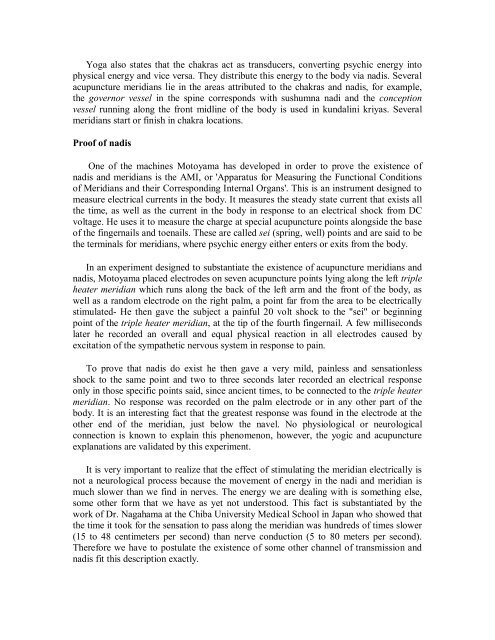Kundalini.Tantra.by.Satyananda.Saraswati
Create successful ePaper yourself
Turn your PDF publications into a flip-book with our unique Google optimized e-Paper software.
Yoga also states that the chakras act as transducers, converting psychic energy into<br />
physical energy and vice versa. They distribute this energy to the body via nadis. Several<br />
acupuncture meridians lie in the areas attributed to the chakras and nadis, for example,<br />
the governor vessel in the spine corresponds with sushumna nadi and the conception<br />
vessel running along the front midline of the body is used in kundalini kriyas. Several<br />
meridians start or finish in chakra locations.<br />
Proof of nadis<br />
One of the machines Motoyama has developed in order to prove the existence of<br />
nadis and meridians is the AMI, or 'Apparatus for Measuring the Functional Conditions<br />
of Meridians and their Corresponding Internal Organs'. This is an instrument designed to<br />
measure electrical currents in the body. It measures the steady state current that exists all<br />
the time, as well as the current in the body in response to an electrical shock from DC<br />
voltage. He uses it to measure the charge at special acupuncture points alongside the base<br />
of the fingernails and toenails. These are called sei (spring, well) points and are said to be<br />
the terminals for meridians, where psychic energy either enters or exits from the body.<br />
In an experiment designed to substantiate the existence of acupuncture meridians and<br />
nadis, Motoyama placed electrodes on seven acupuncture points lying along the left triple<br />
heater meridian which runs along the back of the left arm and the front of the body, as<br />
well as a random electrode on the right palm, a point far from the area to be electrically<br />
stimulated- He then gave the subject a painful 20 volt shock to the "sei" or beginning<br />
point of the triple heater meridian, at the tip of the fourth fingernail. A few milliseconds<br />
later he recorded an overall and equal physical reaction in all electrodes caused <strong>by</strong><br />
excitation of the sympathetic nervous system in response to pain.<br />
To prove that nadis do exist he then gave a very mild, painless and sensationless<br />
shock to the same point and two to three seconds later recorded an electrical response<br />
only in those specific points said, since ancient times, to be connected to the triple heater<br />
meridian. No response was recorded on the palm electrode or in any other part of the<br />
body. It is an interesting fact that the greatest response was found in the electrode at the<br />
other end of the meridian, just below the navel. No physiological or neurological<br />
connection is known to explain this phenomenon, however, the yogic and acupuncture<br />
explanations are validated <strong>by</strong> this experiment.<br />
It is very important to realize that the effect of stimulating the meridian electrically is<br />
not a neurological process because the movement of energy in the nadi and meridian is<br />
much slower than we find in nerves. The energy we are dealing with is something else,<br />
some other form that we have as yet not understood. This fact is substantiated <strong>by</strong> the<br />
work of Dr. Nagahama at the Chiba University Medical School in Japan who showed that<br />
the time it took for the sensation to pass along the meridian was hundreds of times slower<br />
(15 to 48 centimeters per second) than nerve conduction (5 to 80 meters per second).<br />
Therefore we have to postulate the existence of some other channel of transmission and<br />
nadis fit this description exactly.














![[Lonely Planet] Sri Lanka](https://img.yumpu.com/59845622/1/169x260/lonely-planet-sri-lanka.jpg?quality=85)


